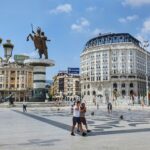“What’s On Your Table?” is a series of articles exploring the relationship between food and systems of power, and how our dining tables shape global cuisine and family histories. You can find a recipe at the bottom of each piece to join in on the meal.
Our Thanksgiving menu shows the zigzagging intersections of American and Spanish colonialism in our respective heritages — John, New Mexican, and Katie, Filipino. We’re replacing turkey with Katie’s Lola’s chicken adobo. We are switching out mashed potatoes and gravy for chauquehue, a northern New Mexican blue corn porridge, topped with red chile. Instead of pumpkin pie, we’ll be preparing flan, the creamy custard that is a staple in both the Philippines and New Mexico. The Philippines and New Mexico are culinary cousins due to Spanish colonialism, but in keeping with the spirit of Thanksgiving, what links them more closely together is not food, but another colonizing power — the United States.
The American education system tends to ignore, or proactively erase, the US role as a colonial power within the 50 states and in former and current territories. Celebrating Thanksgiving as children, we made pilgrim hats out of paper and churned butter without grasping the violence of that first Thanksgiving meal. The Thanksgiving myth marks one starting point for an American history that centers British colonization and then the westward expansion that trampled indigenous ways of life. While that is the core of continental US expansion, we remember, from our own backgrounds, that American imperialism extends far beyond the 50 states. In forgetting US imperialism, we forget how colonization continues beyond the Thanksgiving narrative, even impacting national security today.
TERRA NULLIUS
Before the United States annexed New Mexico and the Philippines, each had a rich history and culture rooted in indigenous practices and influenced by Spanish colonization. The taking of indigenous lands depended on the legal fiction of terra nullius, the idea that the land of non-European populations belonged to no one. The terra nullius myth allowed colonizers to claim others’ land as their own by virtue of having “discovered” it.
New Mexico has a rich history that has little to do with the British colonization story on the eastern seaboard. The oldest continuously inhabited communities in what is now the United States — the New Mexican towns of Taos and Acoma — date back to centuries before Pilgrims and members of the Wampanoag Nation broke bread at the first Thanksgiving. Three decades before the Pilgrims disembarked at Plymouth Rock, Filipinos first arrived in modern-day Morro Bay, California. Before the American Revolution, entire Filipino communities had developed in Louisiana, such as San Malo, a fishing village established by Filipino escapees from the Spanish galleon trade.
After annexing New Mexico in the aftermath of the Mexican-American War, US troops fought a series of “Indian wars” across the West, including campaigns to seize Diné and Apache lands in New Mexico and force them onto reservations. Of the 30 US generals in the Philippines, 26 had been officers in the Indian wars. Resistance to American colonization persisted into the 1880s, when the Apache leader Goyaalé surrendered to American General Nelson Miles, who went on to invade Cuba and Puerto Rico and oversee the American conquest of the Philippines.
AN “EMPIRE OF POINTS”
Overseas colonialism gained momentum in the late nineteenth century with the annexation of territory in the Philippines, Puerto Rico, Hawaii, and elsewhere. The Philippines fell under US dominion after the Spanish-American War, the “splendid little war” in which the United States sought territorial aggrandizement and naval stations to support the growing American navy. American politicians framed colonization in humanitarian terms, claiming a responsibility to civilize “our little brown brothers.” However, the 15-year American conquest of the Philippines was anything but humane; US troops employed waterboarding, concentration camps, and scorched earth tactics.
In forgetting US imperialism, we forget how colonization continues beyond the Thanksgiving narrative, even impacting national security today.
In its occupation of both New Mexico and the Philippines, the United States long treated people as incapable of self-governance — worthy of neither independence nor full inclusion in the US system. In 1940, around one-sixth of the US population comprised non-citizens living in territories, the vast majority of whom were Filipino. White supremacy shaped the diverging American approaches to New Mexico and the Philippines — statehood versus independence. In the Philippines, a fear of Asian migration to the US sparked panic among politicians who sought to prevent Filipino US nationals from coming to the mainland. In New Mexico, American politicians blocked statehood for decades because of the territory’s majority Catholic, Hispanic, and Native American population.
American rule over the Philippines ended in 1946, but the continued presence of American military bases has remained a sensitive subject. Overseas colonialism transformed into an “empire of points” that continues to this day with over 750 US military bases overseas. Keeping military bases in the Philippines was a key provision of the US bill that first promised Filipino independence. The Filipino Senate rejected the bill, but the United States eventually secured a rent-free 99-year lease on 23 military bases and installations, which facilitated operations during the Korean and Vietnam wars. All US military bases in the Philippines finally closed in 1992 following popular protests, and the Filipino Constitution of 1987 banned foreign bases and troops outright unless permitted by a Senate-approved treaty. However, the status of US troops in the Philippines has come to the fore again as the United States seeks a foothold to compete with China, and debates about sovereignty, strategic advantage, and colonialism have resurfaced.
THE WIDE OPEN SPACES THAT AREN’T EMPTY
The United States has long seen not only colonized places but also colonized people through a militarized lens. While the United States has inflicted violence toward those it colonized, the US depends on those same populations to build its forces. Ten hours after the bombing of Pearl Harbor, Hawaii, the Japanese bombed the Philippines. An attack on the Philippines was an attack on American territory, and thus 100,000 Filipinos went to war alongside 20,000 continental Americans. Katie’s Lola recounted stories of hiding in the forest, staying quiet during the Japanese invasion. Katie’s great-grandfather served in the American Navy during World War II — dying in the Bataan Death March without citizenship. In all, at least 250,000 Filipinos served in the US armed services during the war. For those who lived, Filipino veterans’ contributions to the war went without recognition for decades. While those who fought were promised full military benefits, the 1946 Rescission Act took those away, and veterans struggled into the 2000s to receive pay. Far from the theater of battle, civilians in marginalized places on the mainland also felt the consequences of the war project.
The US government chose New Mexico, its second-newest state, as a testing ground for the nuclear weapons that President Harry Truman would drop on Hiroshima and Nagasaki. John’s family hometown of Ruidoso, New Mexico felt the impact of American involvement when hot white snowflakes fell over the town downwind from the Trinity Test — the first detonation of an atomic bomb.
The US government detonated the bomb in White Sands, the gypsum dunes in the homeland of the Mescalero Apache people. Radioactive debris fell from the sky, poisoning nearby communities. The design and building of atomic weapons unfolded in Los Alamos, New Mexico, still home to one of the country’s leading nuclear laboratories. From 1944 to 1986, mining companies extracted thirty million tons of uranium from the Navajo Nation in New Mexico, Arizona, and Utah, causing environmental contamination and health hazards that last to this day. These “wide open spaces” — for developing nuclear weapons, for dispersing land among white settlers, for establishing US military bases — are far from empty.
FOOD, FAMILY, FOREIGN POLICY
The long-lasting impacts of US militarization and colonization are weaved through our family history, our culture — even in our food. For example, beloved Filipino Spaghetti was born out of American colonialism. With a shortage of tomato products during the war, Maria Orosa invented banana ketchup — which General Douglas MacArthur’s staff supposedly used to make him spaghetti one evening. Through scarcity came creativity; through displacement came adaptation.
Spanish colonialism brought flan — originally a Roman dish — around the world. Tables not only in New Mexico and the Philippines but across Latin America now feature the creamy custard. Legend has it that Spanish missionaries in the Philippines used egg whites to mix with quicklime to build churches and made leche flan, the Filipino term meaning milk flan, with the leftover yolks. You can find leche flan in Halo-Halo, the over-the-top unofficial dessert of the Philippines that translates to “mix-mix” in Tagalog. Its layers of beans, macapuno, gulaman, ube ice cream, and more represent the mixes of cultures that have influenced Filipino food throughout its history.
Flan is among the classic New Mexican desserts alongside sopaipillas, biscochitos, and natillas. A creamy, sweet slice of flan helps neutralize the spicy red chile sauce that often tops New Mexican entrees like stacked blue corn enchiladas, a regional staple that features the coarse, nutty cultivar of corn grown in the Pueblos of the Rio Grande Valley for countless generations.
This year, we will be connected by the food we serve at Thanksgiving — both in our enjoyment of the food and in our remembrance of the tangled histories that brought us together to share the meal. As we eat, we will reflect on the colonial relationships that make us New Mexican and Filipina-American and consider how those relationships persist in our homes and other colonized places to this day.
RECIPE FOR FLAN
Ingredients:
1 1/2 cups of granulated white sugar
6 large eggs
1 14 ounce can of sweetened condensed milk
2 13 ounce cans of evaporated milk (or coconut milk)
2 teaspoons of vanilla extract
A pinch of salt
Method:
Preheat your oven to 325 degrees.
- Heat one cup of sugar on medium-high in a pan until it turns into a liquid caramel. While it’s still hot, immediately pour a thin layer into the bottom of your flan mold and quickly tilt the mold so that the sugar reaches the sides before it hardens. New Mexicans use a flanera, a lidded circular metal dish. Filipinos instead use a llanera, which is an oval-shaped mold. If you don’t have one or the other, you can use a ceramic pie tin or a circular pyrex container.
- Blend eggs in a mixing bowl, then blend in condensed milk, evaporated milk, a pinch of salt, and half a cup of sugar. The really traditional New Mexican way to make flan uses goat’s milk instead of cow’s milk. In the Philippines, leche flan usually has only egg yolks instead of whole eggs, and people sometimes use coconut milk instead of cow’s milk.
- Pour the custard mixture into your caramel-lined mold.
- Pour hot water into large bakeware that can fit your flan molds inside of it. Place the custard-filled flan mold into the hot water.
- Bake flan for about one hour at 325 degrees Fahrenheit. Put a knife or a toothpick into the flan, a little off-center, and if it comes out dry, then the flan is ready.
- Let the flan cool completely. Separate the edge of the flan from the side of the mold with the smallest knife you have. Flip the flan onto a large plate and serve.






















